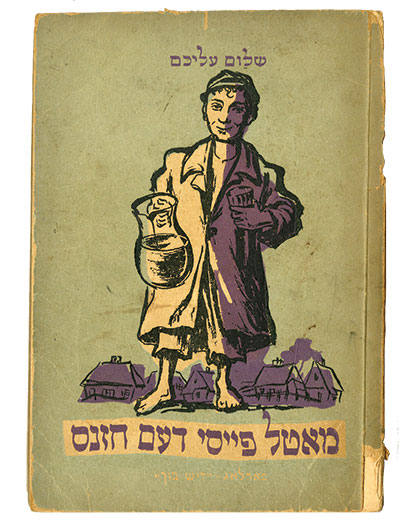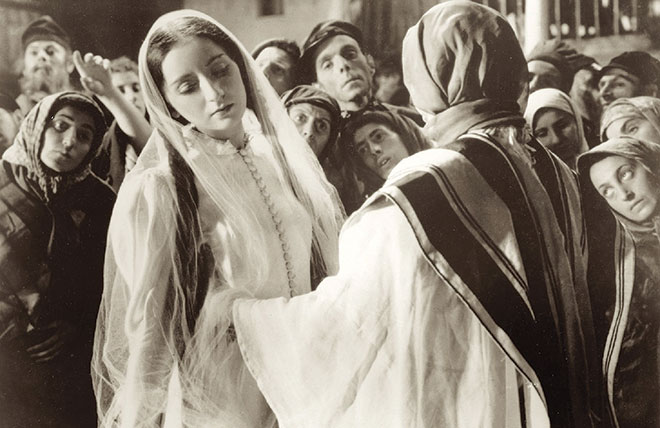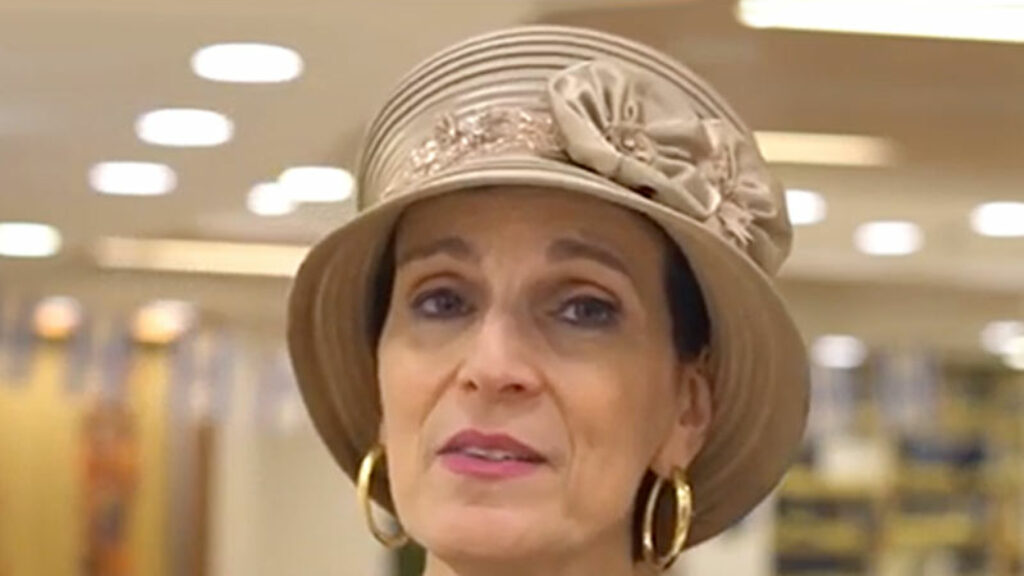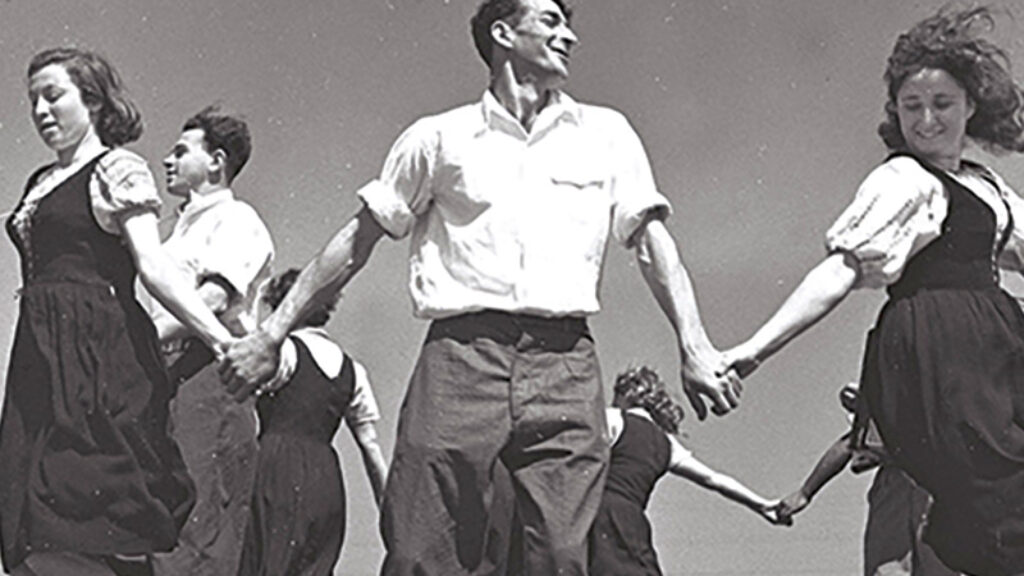Learning Yiddish After 60
Since I was a child, I have always wanted to know Yiddish. Not learn it, not study it—just wake up one day knowing it. When I was about 10, I had a brilliant idea. If my parents would agree to speak only Yiddish with each other, it would just come to me without effort. When I made the suggestion, there was no discussion—discussion was not a thing in our house. I got “the Look,” and we were done.
But now, at 68, I have learned a fair bit of Yiddish, and all since I turned 60. I speak it—a little. I understand much, but by no means all, of what I hear; I read perhaps three or four pages at a time. But I’m still poking along, and I intend to do so indefinitely.

Why have I spent my time on this peculiar hobby? I don’t entirely know, and I have no “just-so” story about how my entire life has led me to this moment. Of course, I’ve had plenty of practice answering the question. Many people have asked me—in fact, everyone I know who isn’t actually studying Yiddish asks. The question is always followed by, “Why do you want to learn a dead language? Who are you going to speak it with?” These are very good questions. I never try to argue that Yiddish is not dead and may be spoken for centuries yet, because, in the common-sense way that they mean, Yiddish is certainly in its last throes.
Yiddish was more present in my early life than in that of some of my contemporaries. My father’s parents got here very late in the great migration of Jews to the United States—my grandfather in 1913 or 1914, my grandmother in 1917. My grandfather Avrom traveled from Babruysk in what is now Belarus to New York, where he became a baker. He left behind my grandmother Anna, intending to send for her and their infant son—my Uncle Sam. Anna was an orphan who had been apprenticed to a bagel baker. At five foot seven inches, she was a Valkyrie among Jewish women. Anna may have spent her childhood in hell baking bagels, but at least someone fed her. Next to my grandpa Avrom, she looked like one of those giant mantises that eats its mate after copulating, only fatter.
But World War I broke out, and the ordinary emigration routes through Hamburg, Trieste, and Liverpool were barred. So in 1916, Anna set out with baby Sam across Russia to Harbin in China; then on to Nagasaki and Yokohama, Japan; by ship to Seattle; and by train to the Lower East Side. Whenever she ran out of money, she waited for my grandfather to send more—through the Hebrew Immigrant Aid Society (HIAS) way stations, I now realize.
The story of my grandparents’ meeting after so many years always required a little Yiddish in my father’s telling. Anna asked Avrom what he did. “I’m a baker.” “And what do you earn?” “Thirty rubles.” “Draysik rubl a kheydesh”? (Thirty rubles a month?) “Neyn, draysik rubl a vokh.” (No, 30 rubles a week.”) “Oy, du bist a noged.” (You’re a prince!) My father was born nine months after this conversation.
My father, naturally, spoke only Yiddish until he went to school. He returned after the first day with much information about the “kindergortn mentshn.” Of course he learned English after that without an accent, if someone who grew up on the Lower East Side and in Brighton Beach could be said to have no accent. Dad always spoke Yiddish with his parents, but by the time I came to consciousness, they lived mostly in Miami Beach, where my grandma had acquired a small hotel.
Thus, my only real exposure to Yiddish was for a week or so in the summer, when my father and I went to the Catskills to help Grandma open her bungalow colony. I thought it was paradise. I now realize that my mother never came along because the whole place was a squalid throwback. (I’m glad I never saw the hotel.) And I couldn’t really speak to my grandparents at all, although my grandma always celebrated our arrival by baking a khale in mitn vokh (a challah in the middle of the week), which in some Yiddish songs is an emblem of the goldene medine.
My grandparents were gone by the time I was 11, and after that I rarely heard my father or anyone else speak Yiddish, except to keep secrets from the children. Dad was no Yiddishist, although he disliked it when people like his brothers called the language “Jewish.” He could not read or write it, but he always claimed to speak a “tife yidish” (deep Yiddish) and I think he was telling the truth. He was even uncool enough (in his generation) to take my mother on a date to see the Yiddish King Lear.
My mother, on the other hand, could understand Yiddish but didn’t speak it with any real fluency. Her parents came to America separately as young teenagers. My grandpa Joe had been a yeshive bokher, who decided, the moment he reached New York, that he would never speak Yiddish again. He died before I was born, but by all accounts he was pigheaded enough to keep his vow. The Yiddish in Mom’s house came from a stream of immigrant relatives and refugees who kept the couch warm through the 1930s, and that’s how she learned the little she knew.
Although I only understood a word here and there, Yiddish always felt very present to me, hovering just beyond the edge of intelligibility, as if only the thinnest of veils kept me from understanding everything. Yiddish somehow underlay everything that was said in our family, every joke, every argument, every bit of rhetoric. As a teenager, I once slammed the kitchen door and was rewarded by my mother saying, “Your head should hit the floor with that sound . . . ”
Actual Yiddish did surface now and then. My mother successfully disposed of my Ayn Rand period, when I was 11, with four words. I was excitedly explaining the plot of Atlas Shrugged to my parents. When I paused for breath, my mother looked at my father and said, “Nu, herts zikh tsu?”—“Are you listening to this?” Her intonation alone returned me to the Democratic Party.
It’s not surprising I wanted to know a language with such power. In college, however, I was deflected by Hebrew. I spent my senior year abroad in Israel with the soon-abandoned notion of making aliyah. I acquired a reasonable spoken Hebrew, although to this day I can just puzzle my way through a newspaper article. I like Hebrew, and I’m very glad to have some, but my feeling about it at the time was like how I felt about Israel itself: “Really nice country, but where are the Jews?”
When I returned to New York in 1971, I hypothesized that the Jews might still be living in Yiddishland, perhaps beyond the Sambatyon, which for my part I would happily cross on Shabes. So I acquired a guide in the form of a copy of College Yiddish, the first (and, at that time, the only) “modern” Yiddish textbook in existence, by Uriel Weinreich, originally published in 1949.
I opened College Yiddish over the years many times. It actually answers the question where the Jews are in its very first page: “Yidn voynen af ale kontinentn”—Jews live on every continent.
Decades passed, and I learned no more Yiddish. What I needed above all was motivation, and I finally found it when I turned 60. When I was a teenager, I read Melford E. Spiro’s book Children of the Kibbutz, about communal child rearing in Israel. I learned from Children of the Kibbutz that many of the Hebrew-speaking children believed that they would go on speaking Hebrew until they were old, when they would suddenly begin to speak Yiddish. Recalling this, I realized that I wished more than anything to be an old man transformed into a Yiddish speaker.
I enrolled in a Yiddish class at the Arbeter Ring (Workmen’s Circle) in Brookline, Massachusetts. I decided that since I was comfortable with the alef-beys and already had a Yiddish vocabulary that extended at least 50 words past “khutspe,” I would join the “Advanced Beginners.” I found I could sound out the words quickly enough, and when I did, noises that closely resembled Yiddish tumbled out. Apparently, I had a Yiddish-speaking dybbuk, although I didn’t really understand a word he was saying.
The teachers conferred and informed me that I really should go upstairs to the literature class. When I got there, I found people, many older than me, some of whom actually spoke Yiddish. This was terrifying. More terrifying was that they were reading Sholem Aleichem—Motl Peyse dem khazans (Motl, the Cantor’s Son). They were reading about Motl’s older brother Elye and his efforts to earn “a hundert rubl a khoydesh” through various get-rich-quick schemes, like selling kvas on the street.“Hundert rubl a khoydesh”—I was saved by my grandfather the noged!
I started to read. Then, and for many weeks, I found myself crossing wide and turbulent streams of Yiddish, in which I landed, every dozen feet, on a familiar Hebrew word. Blah-blah-blah-“exaggeration,” blah-blah-blah-“Pale of Settlement,” blah-blah-blah-“preacher.”
The funny part was that my comrades in the class among them generally understood 11 words out of 12, but were often defeated by that Hebrew word. Thus, I gradually became a resource rather than a burden. The class served up well-known stories like Peretz’s “Oyb nisht nokh hekher” (“If Not Higher Still”) and lesser-known material like an astonishing if imperfect story about the last days of Jewish Vilna, “Tamare di hoykhe,” by Avraham Karpinovich.
These courses did not teach themselves, of course. My teacher over several terms was Lillian (Leye) Leavitt. Over time we read such texts as Got fun nekome (God of Vengeance), although I personally never made it to the good part, and “Yentl der yeshive bokher” (“Yentl, the Yeshiva Boy”) where I did. Leye got her Yiddish, like virtually every native speaker of my generation, from her Holocaust-survivor parents, and she studied with Ruth Wisse at Harvard.
But it was clearly time to acquire some grammar and a more-than-random vocabulary. A trip to the Israel Book Shop in Brookline acquainted me with Sheva Zucker’s Yiddish: An Introduction to the Language, Literature & Culture. To say that it is a very good textbook doesn’t capture what the book did for me. It encompasses a world of Jewish culture in 20 lessons on Purim, Passover, the Sabbath, marriage, the Holocaust, and more. My key decision, after struggling through a few lessons, was to buy the 19 accompanying CDs, which include every song, reading, and story, as well as every exercise in grammar and usage. I listened to them during my commute to work—perhaps an hour a day most weekdays. I don’t know how many times I listened to excerpts from Yehoash’s translation of Megilas Ester, followed by the song “Homentashn”; or a story from I. B. Singer’s “In mayn tatns beys-din shtub.” Ten or 15 times for each is a good guess. I sang songs like “Di mezinke” until I knew them by heart. I particularly enjoyed one disc devoted to Yiddish dialects, including readings of the same material by trained and untrained voices from different regions.

Listening over and over, I began to feel a certain melancholy. The chapter on what I learned to call the “khurbn” rather than the Shoah is naturally affecting, but I began to dread particularly the farewell letter of Shmuel (Arthur) Zygelbojm, written before his suicide in 1943 in the full knowledge of the extermination of the Jews of Poland. For my part, I find the bombast of the “Partizaner lid” difficult to bear, and worse on the tenth hearing. I hope it lifted the spirits of those who first sang it, but it seems so . . . German.
But even the unit on Shabes has its sorrows, although it is centered on Peretz’s wonderful story “Der oytser” (“The Treasure”). A song about how one must borrow to be prepared for the Sabbath, another bitter song about making havdole with nothing in the house for the week to come, another about the misery of a little boy who begs his grandmother not to recite Got fun Avrom, thus ending the Shabes. And grandma also sheds a tear . . . but it’s all authentic Yiddish, and it’s at the furthest remove from the tediously cheery dialogues of most language textbooks. And I hasten to say that there is a lot of laughter in the book, much of it supplied by Sholem Aleichem.
After a year of this on-the-road study plan, I got out of the car feeling that with considerable qualifications I now knew Yiddish, having learned it more or less as I wished to when I was 10—with no apparent effort. In fact, I find myself in an all-too-familiar American Jewish position. In Yiddish, I am still an amhorets (ignoramus), but anyone who knows enough to call himself an amhorets is not one.
So, having crossed the Sambatyon into Yiddishland, where am I going? Anywhere at all—it’s all good, and it stretches on forever. I read, slowly, whenever I get a chance. My beach and pool reading for this summer is The Dybbuk, and if the weather holds I’ll finish it soon. I am up to the trial and exorcism scenes at last. Did An-sky intend those scenes to be amusing? I find them so. I can’t stop smiling at the formidable self-possession of the exorcist-rebbe. He doesn’t even summon the dead to trial himself; he just delegates his gabbai to go to the cemetery with his stick as his warrant. The rebbe even has time for points of rabbinical etiquette, like asking the rov of the town for permission to conduct the excommunication . . . of a ghost. And his judgments, like God’s, are true and righteous altogether.
Why The Dybbuk? Because it’s available with an English translation on facing pages (what we used to call a “trot”). The principle of no effort still applies. I can read Yiddish without a trot if I have to. I made it through 30 pages of Chaim Grade’s Tsemakh Atlas once. I subscribe to Afn shvel (On the Threshold), the literary magazine of the Yiddish League, mostly in support of Sheva Zucker, the editor. I open it, even. But that’s all work.
So why study Yiddish? Learning Yiddish has certainly been a sentimental journey for me. But classic Yiddish literature—even Sholem Aleichem!—is bracingly unsentimental, as well as thrilling in its unfamiliarity. I have literally never read anything like The Dybbuk. And the mental and conceptual world inhabited by its erstwhile speakers really does make Yiddish literature untranslatable.
And yet, I have a confession to make. My father has been dead for 25 years now, but he and I speak all the time. Now that I know some Yiddish, we have two languages to converse in. He’s always very impressed when I offer to make him a “prezhenitse” or some “opgefrishte broyt”—an omelet or some French toast. “How do you know that?” he marvels, before he points out that, as a Litvak, I should really say “breyt.”
Comments
You must log in to comment Log In
Suggested Reading

The Tikkun in Sutzkever’s Work
Elie Wiesel explores the soul and purpose of Holocaust poetry.

Chaim Grade: Portrait of the Artist as a Bareheaded Rosh Yeshiva
Grade attempted to perform the impossible: to undo in literature what had occurred in history and revive the dead of Jewish Vilna.

Repentance and Desire
Mizrachi identifies the heightened energy she senses in the streets of Israel during the days between Rosh Hashanah and Yom Kippur. She renames the period between Rosh Hashanah and Yom Kippur known as the Ten Days of Repentance, “Aseret Yemei Teshuva,” as the “Aseret Yemei Teshuka,” or “Ten Days of Desire,” a time when the yearning for a return to God and Torah reaches a primal, visceral level.

From the Shtiebel to the Hora
More than two hundred songs of the pioneers of the Third Aliyah began their lives as Hasidic tunes. But historian David Assaf’s wonderful new book reaches far beyond the Hasidic world in tracing the origins of the heart of the secular Zionist musical repertoire.
Linda Abraham
I loved the article. At 67, I too yearn to learn... the article was very encouraging, and the references helpful.
Roberta
David Fried wrote about me. Like the author, I always expected I would learn Yiddish by inhaling it from the air around me. But when my mother died, no one was left who could read her Yiddish books. I enrolled in the YIVO summer program and began attending Yiddish Vokh. When I am at Yiddish Vokh, immersed in Yiddish, I am at home. Reading Yiddish literature in its original language gave me a deeper understanding of the world of Eastern European Jewry, permitted me to peek into my parents childhood, and enhanced my understanding of the limits of translation in any language. I came to grasp why my parents were so clear about wanting me to be 100% American. But I am rooted in their past as well. For more than ten years, I led a Yiddish group at an assisted living facility. Too old to learn? Hardly. 10 to 20 people well over the age of 70 came together eagerly week after week in a congenial, supportive environment and step by step learned to read and love good Yiddish literature. For them too, it reverberated deep in their spirit and enriched their lives.